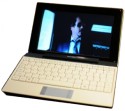Is OLPC jumping to ARM?
Mar 16, 2009 — by Eric Brown — from the LinuxDevices Archive — 1 views ARM-based netbooks are coming soon, say two reports. PC World says that One Laptop per Child (OLPC) will likely move from an x86-based AMD Geode to an ARM processor in its XO-2, and Digitimes says that Freescale i.MX31 and Qualcomm Snapdragon-based netbooks will demo in June.
ARM-based netbooks are coming soon, say two reports. PC World says that One Laptop per Child (OLPC) will likely move from an x86-based AMD Geode to an ARM processor in its XO-2, and Digitimes says that Freescale i.MX31 and Qualcomm Snapdragon-based netbooks will demo in June.
(Click for larger view of a mockup of XO-2)
When AMD announced in January that it had no plans to upgrade the aging Geode platform, the non-profit OLPC, which sells cheap subsidized netbooks to developing nations for educational purposes, appeared to be mulling Intel or Via as replacement vendors for its next-generation XO-2 netbook. Yet now, PC World quotes OLPC chairman Nicholas Negroponte as saying the organization is “almost” committed to putting an ARM-based chip in the XO-2, which is said to be due for release in 18 months.
Battery life is the key factor pushing OLPC toward ARM, as opposed to Intel's Atom or Via's Nano, suggests the story. It quotes OLPC CTO Ed McNierney as saying that ARM processors would draw less power than x86 chips while offering built-in graphics and wireless networking. “Our current XO-1 uses an average of 5 watts of power, and while most people think that's amazingly low, we think it's our biggest problem,” McNierney was quoted as saying.
One problem with moving to ARM is that it would make it more difficult to offer a dual-boot option with a full Windows install alongside Linux, Negroponte is quoted as saying in the story. However, he is said to have added that OLPC is trying to convince Microsoft to develop a version of a full Windows OS for XO-2. Negroponte is also quoted as saying that with the XO-2 (pictured at top), OLPC plans to open up its Linux-based distribution to enable other manufacturers to make their own versions of the XO-2.
The XO-2 will dispense with the keyboard and touchpad and depend solely on dual 16×9-proportioned, sunlight-readable touchscreens, says OLPC. The device can be used as a standard notebook, with one screen revealing a keyboard-like touchscreen interface, or it can be used in e-book mode or as a dual-screen mode for collaborative use and games. The goal is to deliver the device at a volume price of $75 to large educational buyers.
 Always Innovating Touch Book (Click for details) |
A growing list of ARM options for netbooks
The PC World story does not mention which ARM platform OLPC might consider using. So far, the only announced ARM-based netbook that we know of is the Always Innovating Touch Book (pictured at right), which will ship later this Spring with a modified version of the Texas Instruments (TI) BeagleBoard, which incorporates TI's ARM Cortex-A8-based OMAP3530 system-on-chip (SoC).
Meanwhile, Freescale Semiconductor has begun sampling an ARM Cortex-A8-based i.MX515 SoC targeted at the netbook market. Freescale recently announced a reference design for the SoC developed by Pegatron Technology (pictured below). The design is said to offer Android and Xandros Linux ports, as well as support from Phoenix Technogies's HyperSpace fast-boot technology, and support for 3G modules from Wavecom and Option.
 Pegatron reference design for the Freescale i.MX515 (Click for details) |
Xandros also ported its desktop Linux distro to Qualcomm's ARM-based Snapdragon SoC. The first versions of the Snapdragon are based on a 1GHz “Scorpion” microprocessor with 128-bit SIMD (single instruction multiple data) capability, plus a 600MHz low-power, “low-leakage” DSP. According to Qualcomm, they also offer WiFi, Bluetooth, and a “universal broadcast modem” that can receive broadcasts in MediaFLO, SDMB, ISDB-T, TDMB, and DVB-H formats.
Wistrom to tap Snapdragon
All these options may be open to OLPC and other netbook vendors sooner than expected, says a story in Digitimes. Pegatron will ship the Freescale i.MX515 reference design at the Computex Taipei show in June this year, and Wistron will demo a netbook based on the Qualcomm Snapdragon at the same show, says the story.
Netbooks based on a third ARM platform, Nvidia's ARM11-BASED Tegra, will appear at a later time, says the story, adding that Micro-Star International (MSI) will support the platform, which is being ported to the Linux-based Android platform in addition to supporting Windows. MSI and Asustek are both considering Snapdragon-based netbooks, says the story. It is unclear whether any of these netbooks will be Linux-based, although Asustek (Asus) has been rumored to be working on an Android netbook.
Availability
The PC World story about the OLPC may be found here.
This article was originally published on LinuxDevices.com and has been donated to the open source community by QuinStreet Inc. Please visit LinuxToday.com for up-to-date news and articles about Linux and open source.